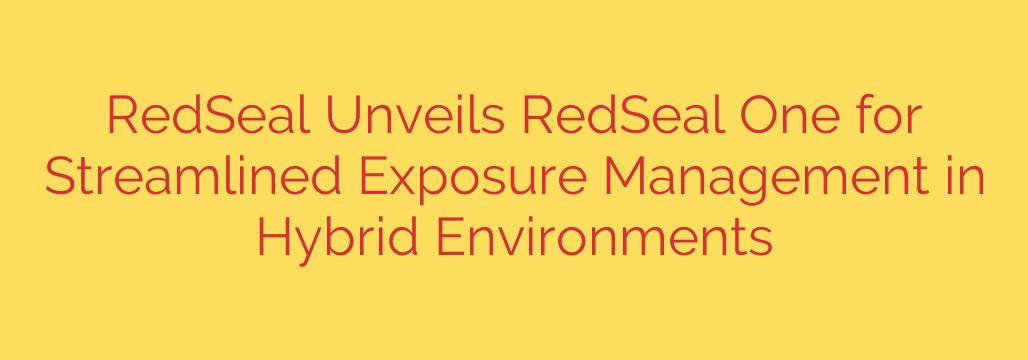
Mastering Hybrid Cloud Security: A Unified Approach to Exposure Management
In today’s fast-paced digital landscape, businesses are increasingly relying on complex hybrid environments. This mix of on-premise data centers and multiple public clouds—like AWS, Azure, and Google Cloud—fuels innovation but also creates a significant security challenge. As your digital footprint expands, so does your attack surface, leaving security teams struggling to maintain visibility and control.
The core problem is fragmentation. Security teams often use a patchwork of tools for different environments, leading to siloed data, alert fatigue, and a lack of context. It’s nearly impossible to answer the most critical question: which vulnerabilities pose the greatest threat to our business right now? A high-severity vulnerability on an isolated server is far less concerning than a medium-severity one on a server that provides a direct path to your most sensitive customer data.
This is where a fundamental shift in strategy is needed—moving from traditional vulnerability management to a comprehensive cyber exposure management approach.
The Limits of Traditional Security Tools
For years, security has focused on identifying and listing vulnerabilities. Teams run scans, generate reports filled with thousands of issues, and then face the daunting task of manually figuring out what to fix first. This approach is no longer sustainable in a hybrid world.
The key challenges with this old model include:
- Lack of Context: A long list of vulnerabilities doesn’t tell you how an attacker could actually chain them together to breach your network.
- Alert Overload: Security analysts are drowning in alerts from disconnected systems, making it easy to miss the truly critical threats.
- Incomplete Visibility: Gaining a single, coherent view of your entire infrastructure—from on-premise servers to cloud containers—is a massive hurdle.
- Inefficient Prioritization: Teams often waste valuable time fixing low-risk issues while high-impact exposure points remain unaddressed.
To truly secure a modern enterprise, you need to see your network the way an attacker does. You need to understand the pathways and connections between assets to identify the routes that lead to your most valuable data.
The Power of a Unified Exposure Management Platform
A modern solution to this problem is a unified exposure management platform. Instead of looking at security in isolated pieces, this approach brings all your environmental data together into a single, cohesive view. By integrating with your existing infrastructure and security tools, it provides the context needed for intelligent decision-making.
Here are the key benefits of adopting a unified exposure management strategy:
Complete Visibility Across Your Entire Network: The first step to securing anything is seeing it. A unified platform provides a comprehensive, up-to-date map of your entire hybrid environment, including on-premise hardware, virtual machines, and all your cloud assets. This eliminates blind spots and provides a single source of truth for your security posture.
Intelligent and Context-Aware Prioritization: This is the game-changer. Instead of just using a generic severity score (CVSS), a modern platform analyzes the connectivity between assets. It helps you prioritize threats based on their actual risk to the business, showing you which vulnerabilities are on internet-exposed assets or provide a pathway to critical applications. This allows you to focus resources where they will have the most impact.
Proactive Attack Path Analysis: A unified platform allows you to think like an adversary. By modeling potential attack paths, you can identify and disrupt how an attacker could move through your network before they ever get the chance. This proactive stance shifts your team from a reactive “whack-a-mole” approach to a strategic defense.
Streamlined Security Compliance and Auditing: Proving compliance in a hybrid environment can be a nightmare of spreadsheets and manual data collection. A unified view dramatically simplifies auditing and compliance reporting by providing a clear, evidence-based picture of your security controls and network segmentation across all environments.
Actionable Security Tips for Your Hybrid Environment
Securing a complex network requires a strategic approach. Here are a few actionable steps you can take to improve your security posture:
- Map Your Full Attack Surface: You can’t protect what you can’t see. Invest in tools and processes that give you a complete inventory of all assets across your on-premise and cloud infrastructures.
- Prioritize with Business Context: Move beyond simply patching everything marked “critical.” Work to understand how your assets are connected and which ones protect your most valuable data. Focus your efforts there first.
- Validate Your Segmentation: Network segmentation is a powerful control, but only if it’s working correctly. Regularly validate that your security zones are properly isolated and that no unintended pathways exist between them.
- Unify Your Security Data: Break down the silos between your security tools. Look for solutions that can aggregate data from your vulnerability scanners, cloud configurations, and network infrastructure to provide a single, contextualized view of risk.
Ultimately, navigating the security complexities of a hybrid world is about gaining clarity and context. By moving towards a unified exposure management strategy, you can empower your security teams to cut through the noise, focus on what truly matters, and proactively defend your organization against evolving threats.
Source: https://www.helpnetsecurity.com/2025/08/06/redseal-one-platform/








